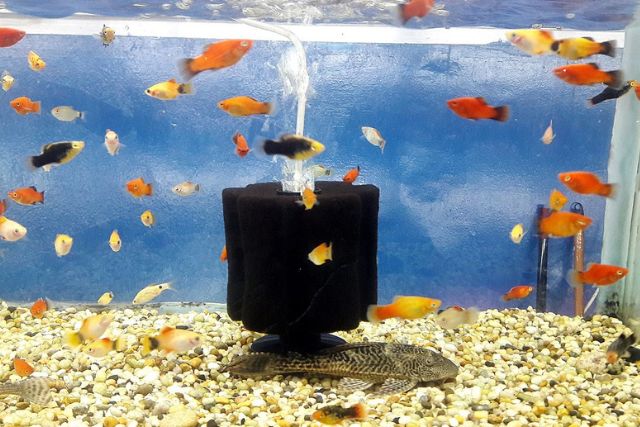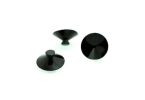Aquarium filters are an essential component of any fish tank setup. They help maintain the water quality and keep your fish healthy by removing debris and waste. However, sometimes the flow of the filter can be too strong, causing stress to your fish and disturbing the decor in your aquarium. In such cases, it becomes necessary to reduce the flow of your aquarium filter.
There are several ways to reduce the flow of your aquarium filter. One of the easiest ways is to adjust the flow control valve on the filter. Most filters come with a flow control valve that allows you to adjust the flow rate. By turning the valve, you can reduce the flow of the filter to a level that is suitable for your aquarium.
Another way to reduce the flow of your aquarium filter is to add a pre-filter sponge. A pre-filter sponge can be attached to the intake of the filter, reducing the flow and trapping debris before it reaches the filter media. This can also help prolong the life of your filter by reducing the amount of debris that needs to be filtered.
Reducing the flow of your aquarium filter is a simple process that can help improve the health and well-being of your fish.
By adjusting the flow control valve or adding a pre-filter sponge, you can reduce the flow of your filter to a level that is suitable for your aquarium.
It is important to note that reducing the flow of your filter can also reduce the filtration capacity, so it is important to monitor the water quality and make adjustments as necessary.
Understanding Aquarium Filtration Systems
Aquarium filtration systems are essential to maintain a healthy aquatic environment for your fish. They help to remove waste, debris, and harmful chemicals from the water, ensuring that the water quality remains optimal.
Understanding the different types of filtration systems available can help you choose the right one for your aquarium and ensure that it functions efficiently.
There are three main types of filtration systems: mechanical, biological, and chemical. Mechanical filters remove debris and waste from the water by trapping it in a filter media, such as sponge or floss.
Biological filters use beneficial bacteria to break down harmful chemicals, such as ammonia and nitrites, into less harmful nitrates. Chemical filters remove impurities from the water by using activated carbon or other chemical substances.
To reduce the flow of an aquarium filter, it’s important to understand the components of the filter. Most filters have an adjustable flow rate that can be controlled by adjusting the valve or flow regulator.
If your filter doesn’t have an adjustable flow rate, you can reduce the flow by adding a flow restrictor or reducing the size of the tubing.
Another way to reduce the flow of your aquarium filter is to add additional filter media. By adding more filter media, you increase the surface area available for beneficial bacteria to grow. This can help to improve the efficiency of the filter and reduce the flow rate.
It’s important to note that reducing the flow rate of your aquarium filter can affect the overall water quality in your aquarium. If the flow rate is too low, waste and debris may not be removed efficiently, leading to poor water quality and potentially harmful conditions for your fish.
Therefore, it’s essential to find the right balance between reducing the flow rate and maintaining a healthy aquatic environment for your fish.
Why Reduce Aquarium Filter Flow?
Aquarium filters are essential for maintaining a healthy aquatic environment for fish and other aquatic creatures.
However, sometimes the flow rate of the filter can be too high, causing issues such as excessive water movement, noise, and even harm to the fish.
Reducing the flow of an aquarium filter can help to alleviate these problems and create a more suitable environment for aquatic life. Here are some reasons why reducing the flow of an aquarium filter might be necessary:
- Minimizing stress on fish: High water flow can cause stress on fish, especially those that prefer calmer waters. Reducing the flow can help to create a more natural and comfortable environment for the fish.
- Preventing harm to delicate creatures: Some aquatic creatures, such as shrimp, can be harmed by high water flow. Reducing the flow can help to prevent injury or death to these delicate creatures.
- Reducing noise: High water flow can create a lot of noise, which can be disruptive and annoying. Reducing the flow can help to create a quieter environment for both the fish and the aquarium owner.
- Saving energy: High flow rates can consume a lot of energy, which can be costly over time. By reducing the flow, aquarium owners can save money on their energy bills.
Overall, reducing the flow of an aquarium filter can have many benefits for both the aquatic life and the aquarium owner. It is important to find the right balance between filtration and water flow to create a healthy and comfortable environment for all.
Methods for Reducing Aquarium Filter Flow
Aquarium filters are essential for maintaining a healthy and clean aquatic environment for fish and other aquatic animals.
However, sometimes the flow rate of an aquarium filter may be too high, leading to discomfort or even harm to the inhabitants of the tank. Here are some methods for reducing the flow of an aquarium filter:
- Adjusting the flow rate: Most aquarium filters come with a flow rate adjustment knob or valve that allows you to adjust the flow rate of the filter. Turning down the flow rate can be an effective way to reduce the flow of the filter. However, it’s important to note that turning down the flow rate too much can lead to reduced filtration efficiency, so it’s important to find a balance that works for your aquarium.
- Adding filter media: Adding filter media, such as sponge or filter floss, to the filter can help to slow down the flow rate of the filter. The filter media provides additional surface area for bacteria to grow, which can help to improve filtration efficiency while reducing the flow rate.
- Using a pre-filter sponge: A pre-filter sponge can be placed over the intake of the filter, which can help to slow down the flow rate of the filter. The sponge also helps to trap larger debris before it enters the filter, which can help to prolong the life of the filter.
- Diverting the flow: Diverting the flow of the filter can also be an effective way to reduce the flow rate. This can be done by using a spray bar or by directing the flow towards a wall or other object in the aquarium. By diverting the flow, you can reduce the direct flow of water and create a more gentle current in the tank.
- Replacing the filter: If all else fails, it may be necessary to replace the filter with one that has a lower flow rate. When selecting a new filter, it’s important to choose one that is appropriate for the size of your aquarium and the type of inhabitants you have.
In conclusion, there are several methods for reducing the flow of an aquarium filter. By adjusting the flow rate, adding filter media, using a pre-filter sponge, diverting the flow, or replacing the filter, you can create a more comfortable and healthy environment for your aquatic pets.







